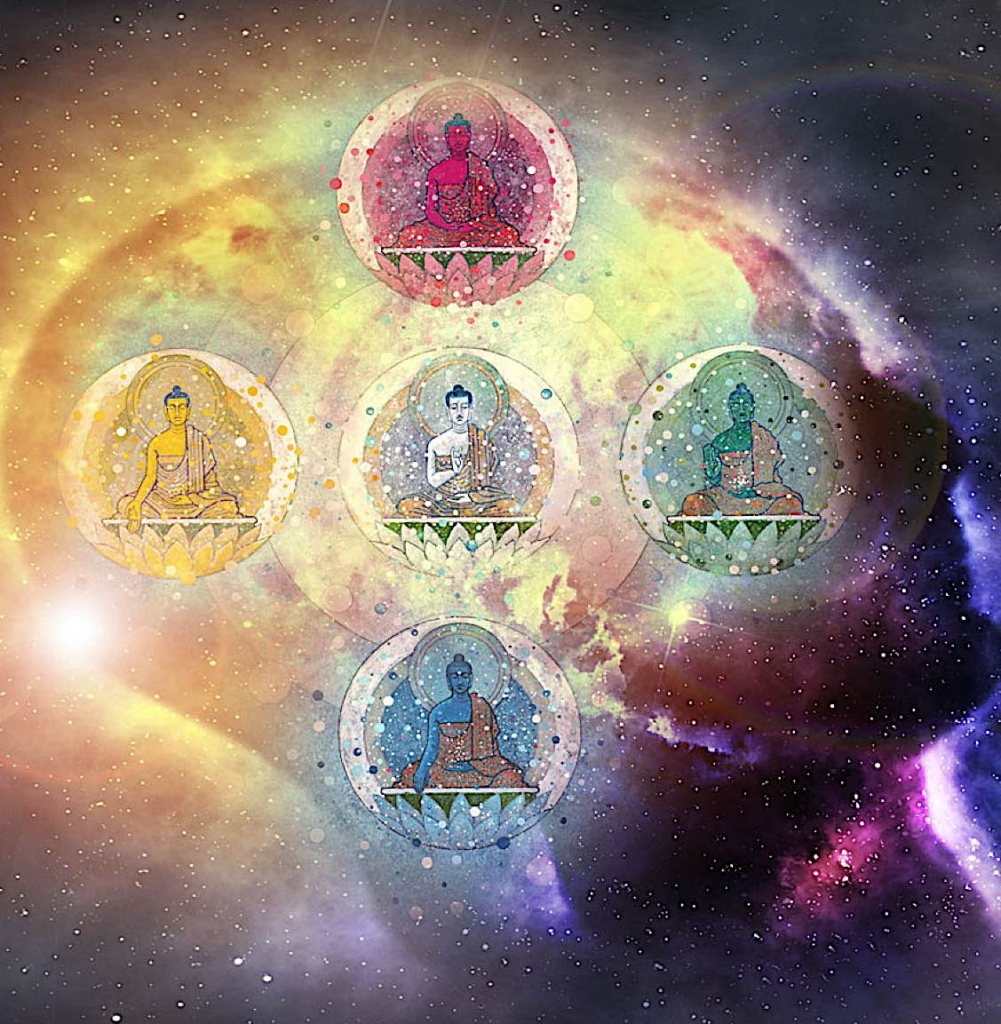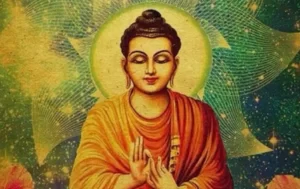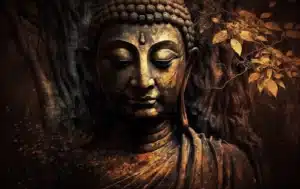The Shurangama mantra, one of the most powerful and profound mantras in Buddhism, has been a source of fascination and inspiration for practitioners for centuries.
Its reputation as the “king of mantras” is not without reason, as its recitation is said to bring immense benefits, such as dispelling darkness, eliminating karma, and even protecting the chanter from fire, water, and poison.
But what is the Shurangama mantra, and why is it considered the essence of Buddhism? In this exploration of the mantra, we will delve into its origin, meaning, and significance, uncovering the secrets and mysteries behind this mantra.
What is Shurangama mantra?
The Shurangama mantra is a powerful invocation of the Avalokitesvara, also known as Guanyin in Chinese, who is revered as the embodiment of compassion and mercy. It is believed that reciting the mantra can help practitioners overcome obstacles, eliminate negative karma, and attain spiritual enlightenment.
Although the Shurangama mantra is an old mantra in Chinese, Japanese, and Korean Buddhism, it is relatively unknown in modern Tibet. However, several texts of the Shurangama mantra can be found in the Vajrayana Buddhist canon and it is related to the Tangmi and Shingon schools.
The word “Shurangama” is translated as “Great Samatha Firmly” which refers to Buddha-nature, the inherent true nature of all sentient beings that is pure and unchanging. This nature is vast and covers the whole universe, hence the name “Great”, and it is not affected by impermanence, so it is called “Firmly”. Reciting the Shurangama mantra directs the mind towards this “Great Samatha Firmly” nature.
The Origin of Shurangama mantra

The Shurangama mantra is derived from the Shurangama Sutra, which is believed to have been transmitted by the Buddha to Manjushri bodhisattva. The sutra teaches about the nature of consciousness and how it can be purified and transformed through the practice of mindfulness and insight.
According to Buddhist tradition, the Shurangama Sutra was first preached by the Buddha in response to a challenge from the demon king Mara, who sought to undermine the Buddha’s teaching. The sutra recounts how the Buddha, with the help of the Manjushri, overcame Mara’s challenges and delivered a profound teaching on the nature of mind and the path to enlightenment.
The Shurangama Sutra is considered to be one of the most important sutras in Mahayana Buddhism, and its teachings on mindfulness and insight are considered essential for the attainment of spiritual enlightenment. The Shurangama mantra is a key element of the sutra’s teachings, and it is believed to have been transmitted by the Avalokitesvara as a means of spiritual protection and purification.
In 168-179 BC, the bhikkhu Shramana Lokasema arrived in China. During the Tang dynasty, he translated and transliterated the now-popularized version of the Shurangama Sutra and the Shurangama mantra from Sanskrit into Chinese. To this day, this mantra is recited by monks and nuns in the Chinese Buddhist tradition, as well as by many Buddhists of other schools, as an essential aspect of daily practice.
The Meaning of Shurangama mantra

The Shurangama mantra is also known as the “Crown of the Buddha”. It is so powerful that the beautiful light of the mantra floods every place in space or the entire Dharma Realm.
It is difficult to explain the Shurangama mantra line by line or word for word, and possibly no one fully understands it. However, Venerable Thich Tri Hue will do my best to explain its general purpose.
The mantra consists of five councils representing the five directions: East, West, South, North, and Center. The East is led by Akshobhya as the presiding officer, the South is led by Ratna-saṃbhava, the Center is a division of Buddhas with Shakyamuni Buddha as the presiding officer, the West is led by Amitabha Buddha, and the North is the karmic division, Amoghasiddhi.
The Five Buddhas (or Five Dhyani Buddhas) watch over the five armies of demons within us and in this world. Because of these demons, the Buddhas divided into five directions to limit their disturbance. When reciting the Shurangama mantra, the five armies of demons in the five directions surrender to its power. They cannot resist the Shurangama mantra, which is why the five Buddha divisions make it the most powerful mantra in Buddhism.
Many people ask on Buddhist forums, “What is the effect of the Surangama Mantra? Should I chant the Surangama Mantra?” However, attachment should be avoided because it will not be helpful. If a person relies only on mantras and their inner nature is filled with false and malicious thoughts, negative and impure thoughts, and lustful thoughts, the mantra will be ineffective and sometimes counterproductive. To avoid disaster, one must first clear their own mind.
The purity of the mind is what truly dispels calamities. If a person is full of greed, anger, and stupidity, no mantra will work. To chant the Shurangama Mantra, one must be kind and full of goodness and have the desire to help others.
The Benefits of chanting Shurangama mantra

Many people believe that if they chant the Shurangama mantra, the world will continue to exist. However, if no one else recites the mantra, the world will quickly be destroyed because the Dharma will cease to exist.
Each sentence of the mantra is a favorite method of the Buddhas, with each word possessing high, profound, and wonderful points and inconceivable divine powers. Chanting even a single sentence or word of the mantra can cause the heavens and earth to shake, ghosts and gods to cry, and demons to stay away. The power of the mantra can dispel all darkness and allow the practitioner to accomplish all good merit.
If you uphold the Shurangama mantra and perform good deeds, you will attain the state of righteous enlightenment and become a Buddha in the future. Regular recitation of the mantra can eliminate the karma of many previous lives.
The Shurangama mantra is known as the mother of the Buddhas because all Buddhas in the ten directions are born from it, and all Tathagatas rely on it to attain the path of unsurpassed righteous enlightenment. The mantra has the power to save sentient beings from suffering, prophesy for them, and liberate them from excess rights.
In the Dharma-ending age, those who memorize or encourage others to memorize the mantra are protected from harm by fire, water, and poison. Even those who recite the mantra often will not be reborn in bad realms, as the mantra holds them back from such places.
Chanting the Shurangama mantra can generate concentration and open wisdom, allowing the practitioner to understand all things in 84,000 countless eons. If the mind is scattered, Vajra Bodhisattva will silently protect the practitioner until concentration is generated.
Shurangama mantra in Sanskrit
Part I
Namaḥ sarva Buddha bodhi-satve-bhyaḥ
Namaḥ saptānāṃ samyak-saṃbuddha koṭīnāṃ sa-śrāvaka
saṃghānāṃ Namo loke arhattāṃ
Namaḥ srotāpannānāṃ
Namaḥ sakṛdāgāmināṃ.
Namaḥ anāgāmināṃ.
Namo loke samyag-gatānāṃ samyak-prati-pannānāṃ
Namo devarṣiṇāṃ
Namaḥ siddha-vidyā-dhāra-rṣiṇāṃ, śāpānugraha-samarthānāṃ.
Namo brahmaṇe. Namaḥ indrāya.
Namo bhagavate rudrāya umāpati-sahīyāya.
Namo bhagavate nārāyaṇāya,
lakṣmi paṃca-mahā-mudrā namas-kṛtāya.
Namo bhagavate mahā-kālāya, tripura-nagara-vidrāpaṇa-karāya,
adhi-muktaka śmaśāna-vāsine, mātṛ-gaṇa namas-kṛtāya.
Namo bhagavate tathāgata kulāya.
Namo bhagavate padma kulāya.
Namo bhagavate vajra kulāya.
Namo bhagavate maṇi kulāya.
Namo bhagavate gaja-kulāya.
Namo bhagavate dṛḍha-śūra-sena-pra-haraṇa-rājāya, tathāgatāya
arhate samyak-saṃbuddhāya.
Namo bhagavate amitābhāya, tathāgatāya arhate samyaksaṃbuddhāya. Namo bhagavate akṣobhyāya, tathāgatāya arhate
samyak-saṃbuddhāya. Namo bhagavate bhaiṣajya-guru-vaiḍūrya-prabha-rājāya, tathāgatāya arhate samyaksaṃbuddhāya.
Namo bhagavate saṃpuṣpita-sālendra-rājāya,
tathāgatāya arhate samyak-saṃbuddhāya.
Namo bhagavate śākyamunaye,
tathāgatāya arhate samyak-saṃbuddhāya.
Namo bhagavate ratna-kusuma-ketu-rājāya,
tathāgatāya arhate samyak-saṃbuddhāya.
Teṣāṃ namas-kṛtva imāṃ bhagavata stathāgatoṣṇīṣaṃ,
Sitātapatraṃ namāparājitaṃ pratyaṅgirāṃ. Sarva bhūta-graha
nigraha-karaṇīṃ.
Para vidyā cchedanīṃ.
Akālaṃ-mṭtyu pari-trāṇa-karīṃ.
Sarva bandhana mokṣaṇīṃ.
Sarva duṣṭa duḥ-svapna nivāraṇīṃ. Caturaśītīnāṃ graha
sahsrāṇāṃ vi-dhvaṃsana-karīṃ. Aṣṭā-viṃśatināṃ nakśatrāṇāṃ
vi-dhvaṃsana-karīṃ. Sarva śatrū nivāraṇīṃ.
Ghoraṃ duḥ-svapnānāṃ ca nāśanīṃ.
Viṣa śastra agni uttaraṇīṃ. Aparājitaṃ mahā-ghorāṃ, Mahā-
balām mahā-caṇḍāṃ mahā-dīptaṃ mahā-tejaṃ, Mahā-śvetām
mahā-jvalaṃ mahā-balā pāṇḍara-vāsinī Ārya-tārā bhṛkuṭīṃ ceva
vijaya vajra-maleti vi-śrutāṃ, Padmaṃkaṃ vajra-jihva ca mālā-
cevāparājita, Vajrā daṇḍīṃ viśālā ca śanta vaideva-pūjitāṃ,
Saumya-rūpaṃ mahā-śvetā,
Ārya-tārā mahā-bala aparā vjra śaṇkalā ceva, Vajra kaumāri
kulan-dharī,
Vajra hastā ca mahā-vidyā kāṃcana mālikā,
Kusuṃbhā ratna ceva vairocanā kulāthadāṃ uṣṇīṣa, vi-jṛmbhamānā ca savajra kanaka prabha locana, vajrā tuṇḍī ca śvetā ca
kamalākṣī śaśī-prabha, ityete mudra gaṇā, sarve rakṣaṃ
kurvantu mama sarva satvānāṃ ca.
Part II
Oṃ ṛṣi-gaṇa praśāstaya sarva
tathāgatoṣṇīṣāya hūṃ trūṃ.
Jambhana-kara hūṃ trūṃ.
Stambhana-kara hūṃ trūṃ.
Mohana-kara hūṃ trūṃ.
Mathana-kara hūṃ trūṃ.
Para-vidyā saṃ-bhakṣaṇa-kara hūṃ trūṃ.
Sarva duṣṭānāṃ stambhana-kara hūṃ trūṃ.
Sarva yakṣa rākṣasa grahāṇāṃ, vi-dhvaṃsana-kara hūṃ trūṃ.
Caturaśītīnāṃ graha sahasrāṇāṃ. vi- dhvaṃsana-kara hūṃ trūṃ.
Aṣṭā-viṃśatīnāṃ nakṣatrānāṃ pra-sādana-kara hūṃ trūṃ.
Aṣṭānāṃ mahā-grahāṇāṃ utsādana-kara hūṃ trūṃ.
Rakṣa rakṣa māṃ.
Bhagavan stathāgatoṣṇīṣa
sitātapatra mahā vajroṣṇīṣa,
mahā pratyaṅgire mahā sahasra-bhuje sahasra-śīrṣe. koṭī-śata
sahasra-netre, abhedya jvalitā-taṭaka, mahā-vjrodāra tṛ-bhuvana
maṇḍala.
Oṃ svastir bhavatu māṃ mama.
Part III
Rāja-bhayā cora-bhayā udaka-bhayā agni-bhayā, viṣa-bhayā
śastra-bhayā para-cakra-bhayā du-bhikṣa-bhayā, aśani- bhayā
akāla-mṛtyu-bhayā dharaṇī-bhūmi-kampā-bhayā ulkā-pātabhayā, rāja-daṇḍa-bhayā suparṇi-bhayā nāga-bhayā vidyutbhayā. Deva-grahā nāga-grahā yakṣa-grahā rākṣasa-grahā pretagrahā, piśāca-grahā bhūta-grahā kumbhaṇḍa-grahā pūtana-grahā,
kaṭa-pūtana-grahā skanda-grahā apasmāra-grahā utmāda-grahā,
cchāya-grahā revati-grahā jamika-grahā kaṇṭha-kamini-grahā.
Ojāhāriṇyā garbhāhāriṇyā jātāhāriṇyā jīvitāhāriṇya,
rudhirāhāriṇyā vasāhāriṇyā māṃsāhāriṇyā medāhāriṇyā,
majjāhāriṇyā vāntāhāriṇyā asucyāhāriṇyā ciccāhāriṇyā, teṣāṃ
sarveṣāṃ.
Sarva grahāṇāṃ vidyāṃ cchinda-yāmi kīla-yāmi. Pari-brajāka
kṛtāṃ vidyāṃ cchinda-yāmi kīla-yāmi. Ḍāka-ḍākinī kṛtāṃ
vidyāṃ cchinda-yāmi kīla-yāmi Mahā-paśupati rudra kṛtāṃ
vidyāṃ cchinda-yāmi kīla-yāmi. Nārāyaṇā paṃca mahā mudrā
kṛtāṃ vidyāṃ cchinda-yāmi kīla-yāmi Tatva garuḍa sahīyāya
kṛtāṃ vidyāṃ cchinda-yāmi kīla-yāmi Mahā-kāla mātṛgaṇa
sahīyāya kṛtāṃ vidyāṃ cchinda-yāmi kīla-yāmi. Kāpālika kṛtāṃ
vidyāṃ cchinda-yāmi kīla-yāmi.
Jayakarā madhukara sarvārtha-sādhaka kṛtāṃ,
vidyāṃ cchinda-yāmi kīla-yāmi
Catur-bhaginī bhratṛ-paṃcama sahīyāya kṛtāṃ,
vidyāṃ cchinda-yāmi kīla-yāmi.
Bhṛṅgi-riṭika nandi-keśvara gaṇapati sahīya kṛtāṃ,
vidyāṃ cchinda-yāmi kīla-yāmi.
Nagna-śramaṇa kṛtāṃ vidyāṃ cchinda-yāmi kīla-yāmi. Arhanta
kṛtāṃ vidyāṃ cchinda-yāmi kīla-yāmi.
Vīta-rāga kṛtāṃ vidyāṃ cchinda-yāmi kīla-yāmi.
Vajra-pāṇi guhyakādhipati kṛtāṃ vidyāṃ cchinda-yāmi kīlayāmi.
Part IV
Bhagavata stathāgatoṣīṣaṃ sitātapatraṃ namo-stute.
Asitānalārka prabha-sphuṭa vikasitātapatre.
Jva jvala dhaka-khaka vidhaka-vidhaka dara dara vidara vidara,
cchinda cchinda bhinda bhinda, hūṃ hūṃ phaṭ! phaṭ! svāhā.
Hehe phaṭ. Amogha phaṭ. Apratihata phaṭ. Vara-prada phaṭ.
Asura vidrāpaka phaṭ. Sarva deve-bhyah phaṭ. Sarva nāge-bhyaḥ
phaṭ Sarva yakṣe-bhyaḥ phaṭ. Sarva rākṣase-bhyaḥ phaṭ.
Sarva garuḍe-bhyaḥ phaṭ. Sarva gāndharve-bhyaḥ phaṭ.
Sarva asure-bhyaḥ phaṭ. Sarva kindare- bhyaḥ phaṭ.
Sarva mahorage- bhyaḥ phaṭ. Sarva manuṣe- bhyaḥ phaṭ.
Sarva amanuṣe- bhyaḥ phaṭ. Sarva bhūte- bhyaḥ phaṭ.
Sarva piśāce- bhyaḥ phaṭ. Sarva kumbhaṇḍe- bhyaḥ phaṭ. Sarva
pūtane- bhyaḥ phaṭ. Sarva kaṭa-pūtane- bhyaḥ phaṭ. Sarva durlaṅghite- bhyaḥ phaṭ. Sarva duṣ-prekṣite- bhyaḥ phaṭ. Sarva
jvare- bhyaḥ phaṭ. Sarva apasmāre- bhyaḥ phaṭ.
Sarva śramaṇe- bhyaḥ phaṭ. Sarva tirthike- bhyaḥ phaṭ.
Sarva utmāde- bhyaḥ phaṭ. Sarva vidyā-rājācārye- bhyaḥ phaṭ.
Jayakarā madhukara sarvārtha-sādhake- bhyaḥ phaṭ.
Sarva vidyācārye- bhyaḥ phaṭ. Catur bhaginī- bhyaḥ phaṭ. Vajra
kaumārī kulan-dharī mahā-vidyā-rājebhyaḥ phaṭ. Mahā-
pratyaṅgire-bhyaḥ phaṭ. Vajra śankalāya phaṭ. Mahā-
pratyaṅgira-rājāya phaṭ.
Mahā-kālāya mahā-mātṛ-gaṇa namas-kṛtāya phaṭ. Vaisnavīye
phaṭ. Brahmaṇīye phaṭ. Agnīye phaṭ. Mahā-kālīye phaṭ. Kāla-
daṇḍīye phaṭ. Indrīye phaṭ. Raudrīye phaṭ. Cāmuṇḍīye phaṭ.
Kāla-rātrīye phaṭ.. Kāpālīye phaṭ. Adhi-muktaka śmaśāna
vāsinīye phaṭ.
Yeke-citta satva mama.
Part V
Duṣṭa-cittā pāpa-cittā raudra-cittā vi-dveṣa amaitra-cittā.
Utpāda-yanti kīla-yanti mantra-yanti japanti juhvanti. Ojāhārā
garbhāhārā rudhirāhārā vasāhārā, majjāhārā jātāhārā jīvitāhārā
malyāhārā, gandhāhārā puṣpāhārā phalāhārā sasyāhārā. Pāpacittā duṣṭa-cittā raudra-cittā.
Yakṣa-graha rākṣasa-graha preta-graha piśāca-graha,
bhūta-graha kumbhaṇḍa-graha skanda-graha utmāda-graha,
cchāya-graha apasmāra-graha ḍāka-ḍākinī-graha, revati-graha
jamika-graha śakuni-graha mantra-nandika-graha, lamvikagraha hanu kaṇṭha-pāṇi-graha.
Jvara ekāhikā dvaitīyakā straitīyakā catur-thakā. Nitya-jvarā
viṣama-jvarā vatikā paittikā,
śleṣmikā san-nipatikā sarva-jvarā.
Śirortti ardhavabhedaka arocaka,
akṣi-rogaṃ nasa-rogaṃ mukha-rogaṃ hṛd-rogaṃ gala-grahaṃ,
karnṇa-śūlaṃ danta-śūlaṃ hṛdaya-śūlaṃ marma- śūlaṃ, pārśvaśūlaṃ pṛṣṭha-śūlaṃ udara-śūlaṃ kaṇṭī-śūlaṃ, vasti-śūlaṃ ūruśūlaṃ jāṅgha-śūlaṃ hasta-śūlaṃ, pāda-śūlaṃ sarvāṅgapratyaṅga-śūlaṃ.
Bhūta vetāḍa ḍāka-ḍākinī jvara.
Dadru kāṇḍu kiṭibhalotavai sarpa-lohāliṅga,
śūṣatra sagara viśa-yoga,
agni udaka mara vaira kāntāra akālaṃ-mṛtyu.
Traibuka trai-laṭaka vṛścika sarpa nakula,
siṃgha vyāghra ṛkṣa tarakṣa mṛga,
sva-para jīva teṣāṃ sarveṣāṃ.
ṣitātapatraṃ mahā-vjroṣṇīṣaṃ mahā-pratyaṅgiraṃ. Yāvadvā-
daśa yojanābhyantareṇa, sīmā-bandhaṃ karomi, diśā-bandhaṃ
karomi, pāra-vidyā-bandhaṃ karomi, tejo-bandhaṃ karomi,
hasta-bandhaṃ karomi , pāda-bandhaṃ karomi, sarvāṅgapratyaṅga-bandhaṃ karomi.
Tadyathā: Oṃ anale anale viśade viśade vīra vjra-dhare, bandha
bandhani, vajra-pāṇi phaṭ! hūṃ trūṃ phaṭ! svāhā. Namaḥ
stathāgatāya sugatāya arhate samyak-saṃbuddhāya, siddhyantu
mantra-pada svāhā.
How to Chant Shurangama mantra

As shared above, Shurangama mantra is an extremely powerful mantra, so it requires the chanter to meet the following conditions:
- Keeping the five precepts
- Cultivating compassion
- Keeping body – speech – pure mind
Must be compassionate towards all living beings, even towards the Heavenly Demon or the Great Devil, only a compassionate mind; a thought of anger, hatred, reproach, greed… in the mind also absolutely must not arise. If you meet the three minimum conditions above, then chant, if you lack one, you shouldn’t chant! Why? Because the Shurangama mantra is the king of mantras, the power of heaven and earth and the power to suppress demons. If a person has no virtue and does not accumulate merit, no matter how many times he chanted the mantra, it will not work.
Although the Surangama mantra is the longest and most difficult, it sounds the best when chanting. The Buddha’s son meets the Shurangama mantra is a great predestined cause. Moreover, who understands the meaning of the Shurangama mantra, the benefits are inconceivable.
The Shurangama mantra is considered the essence of Buddhism, whether monastics or lay people, reciting every day, the merit is inconceivable. Helping Buddhists grow in wisdom and overcome all obstacles challenge on the path of practice, and at the same time help protect the righteous Dharma, stay in the world for a long time, and benefit sentient beings.
The above boundless benefits are due to the LotusBuddhas extracted from many sources on the internet, of course, the Shurangama mantra is a very important mantra in Buddhism, but only for the benefits listed above that we try our best. Reciting when not understanding the main purpose of Buddhism, with a sincere heart, a pure mind, not mixed with evil, then chanting mantras will be effective.





